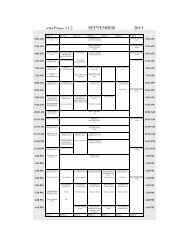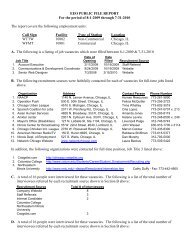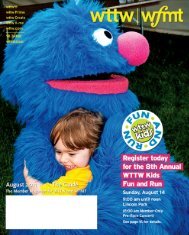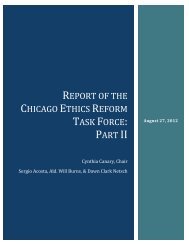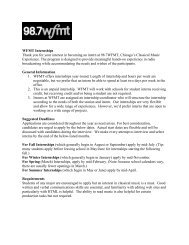Associations Between Family Structure Changes and ... - PAA 2012
Associations Between Family Structure Changes and ... - PAA 2012
Associations Between Family Structure Changes and ... - PAA 2012
Create successful ePaper yourself
Turn your PDF publications into a flip-book with our unique Google optimized e-Paper software.
FAMILY CHANGE AND CHILD DEVELOPMENT 3<strong>Associations</strong> between <strong>Family</strong> <strong>Structure</strong> <strong>Changes</strong> <strong>and</strong> Children’s Behavior:The Moderating Effects of Timing <strong>and</strong> Marital BirthOver the last 40 years, rates of divorce <strong>and</strong> nonmarital childbirth have risen precipitously in theU.S. (U.S. Census Bureau, 2006; Ventura, 2009). Because divorce implies a family transition (into asingle-parent family <strong>and</strong>/or a blended family) <strong>and</strong> non-marital childbirths are often followed by familytransitions (Osborne & McLanahan, 2007), these trends mean most children in the U.S. will experienceone or more changes in family structure (Andersson, 2002; Bumpass & Lu, 2000). For this reason, recentresearch on family structure <strong>and</strong> child development has focused on the implications of family structurechanges, specifically, for child well-being. These studies have found that experiencing a family structurechange, of various kinds, predicts poorer behavioral outcomes in middle childhood <strong>and</strong> adolescence thanstable family structures, of any kind (Albrecht & Teachman, 2004; Cavanagh, Crissey, & Raley, 2008;Hill, Yeung, & Duncan, 2001; Magnuson & Berger, 2009; Fomby & Cherlin, 2007; Osborne &McLanahan, 2007; Wu & Martinson, 2003). Some studies have even found that it is change in familystructure, <strong>and</strong> not residence in a single-parent or blended family per se, that links family structure to childwell-being (e.g., Wu & Martinson, 1993). Overall, this literature suggests that changes in family structuremay meaningfully influence children’s behavioral development.The present study extends this literature by investigating the developmental <strong>and</strong> environmentalconditions under which family structure change may matter most to child well-being. Life course theorysuggests that the impact of family change on children’s outcomes should depend on the timing ofdisruption in children’s lives (Elder, 1998). Although some studies have compared the effects familychange by child age, none have done so in a way that distinguishes immediate from long-term effects(Cavanagh & Huston, 2006; 2008; Hill, Yeung, & Duncan, 2001; Wu & Martinson, 1993; Wu &Thomson, 2001). Making this distinction not only captures the duration of family change effects, it alsoavoids inadvertently highlighting early changes, which may precede a series of stressful eventsthroughout childhood, or later changes, which may be more proximal to the outcome measurement (Hao
FAMILY CHANGE AND CHILD DEVELOPMENT 7Although these models rely on changes in family structure, they are typically employed toestimate the impact of family structure states not family structure changes (Dunifon & Kowalski-Jones,2002; Foster & Kalil, 2007; Hao & Xie, 2002; Ram & Hou, 2003). This approach assumes that the effectof moving into a family structure approximates the effect of living in that state for a longer time, anassumption the preceding literature undermines. Models that rely on family changes more accuratelyestimate the effects of family change than family state. Moreover, change models typically examineconcurrent associations between family change <strong>and</strong> child outcomes even though family change mightimmediately disrupt children’s home environments, <strong>and</strong> behavior as a result, but most children maysubsequently recover from that disruption. Models that estimate the effects only of concurrent changesignore this possibility. Finally, no studies using change models have allowed for separate effects by childage at the time of disruption. This omission assumes that the effects of family change are comparableacross developmental periods.The Moderating Effect of Timing of <strong>Family</strong> ChangeTheoretically, the impact of family change on child behavior should depend on the child’s age atthe time of disruption because children are differentially vulnerable to environmental influences over time(Elder 1998). <strong>Family</strong> disruption during the first three years of life should impact children more stronglythan changes later in childhood because infants <strong>and</strong> toddlers require more intensive parenting <strong>and</strong>supervision than older children (Drago, 2009; Kalil, Ryan, & Corey, 2011) <strong>and</strong> the home serves asinfants’ <strong>and</strong> toddlers’ primary development context (Collins, Madsen, & Susman-Stillman, 2002;Shonkoff & Phillips, 2000). Children may also be most vulnerable to changes during the first three yearsas they undergo crucial brain development <strong>and</strong> form fundamental attachments with parents, processes thatestablish developmental trajectories that are mutable but increasingly difficult to change over time(Ainsworth, Blehar, Waters, & Wall 1978; Bowlby 1969; Carnegie Corporation, 1994). Although much
Een rit over het circuit van Albacete.TechniekAccessoiresFabrieksoptiesKleurenTechnische gegevensSportR 1200 SSpanien4 e versnelling1008 Net zoals bocht 5.Hier pak je de linkercurbs mee om voluitte accelereren.1 Het aansnijpunt ligtaan de binnenzijdevan de bocht. Bij hetuitaccelereren de linkercurbs gebruiken(niet bij nat weer).2 Hier probeer je het aansnijpunt iets verderopte leggen, zodat je op het korterechte stuk erna nog kunt accelereren.3 e versnelling502 e versnelling3 Al in het begin van de bocht de linkercurbs opzoeken, om de machine zo snelmogelijk te kunnen oprichten en vol tekunnen acceleren.7 Net zo rijden als in bocht 3.3 e versnelling6 Exact middenin de bocht rechtsrijden en snel accelereren op hetkorte rechte stuk.3 e versnelling3 e versnelling5 Het hele stuk langs de linker curbs rijden,om de erop volgende rechter bocht optimaalte kunnen nemen.2 e versnelling2 e versnelling9 Hier moet je de machinesnel omgooien. Je xeertje blik op de binnenzijdevan de linker bocht. Bijhet uitaccelereren niette veel naar rechts gaan,zodat je optimaal delaatste bocht voor de nish kunt nemen.4 e versnelling504 In deze snelle bocht naar links zijn hogesnelheden mogelijk. Je moet wel durven.3 e versnelling3 e versnellingStart / finish1005 e versnelling4 e versnelling10 Vroeg langs de curbs aan de binnenzijde rijden.De motor zo snel mogelijk oprichten om zoveelmogelijk snelheid op de nishlijn te hebben.0 50 100 mRempuntCoureur Markus Barth heeft in de loop van zijn motorsportcarrière al veel overwinningen geboekt.De Duitser was reeds in eigen l<strong>and</strong> motocrosskampioen en kampioen in de Supersportklasse. Tweemaal won hij de zwaarste stadsrace ter wereld, de GP van Macau. Op het circuit van Albacete inSpanje testte hij de BMW R 1200 S. Hier enkele tips van zijn h<strong>and</strong> om een snelle tijd neer te zetten.14 - 15
FAMILY CHANGE AND CHILD DEVELOPMENT 9studies have compared the effects of transitions into a social parent family at different ages or comparedthese effects to those of transitions into a single parent family at different ages.The Moderating Effect of Marital Birth Status on <strong>Family</strong> ChangeMuch of the public <strong>and</strong> policy concern over family instability is focused on children in fragilefamilies because children in these families experience more instability than those born to married parents(Osborne & McLanahan, 2007). However, there are three reasons to hypothesize that family changes mayimpact children less in fragile families than married parent families. First, because single parent <strong>and</strong>blended families are more common among fragile families (Osborne, Manning, & Smock, 2008), parents<strong>and</strong> children in fragile families may perceive changes into these structure as more normative, morepredictable, <strong>and</strong>, thus, less stressful (Maier & Seligman, 1976). Second, stress theory posits that changesare less disruptive when they are accompanied by a strong support system. Mothers in fragile families aremore likely to live with extended kin than married parents, even when they cohabit with the child’s father,<strong>and</strong> to move in with extended kin after relationship dissolution (Sigle-Rushton & McLanahan, 2002).These kin could buffer mothers <strong>and</strong> children against the destabilizing effects of family change.Third, the coresidence of the biological father is associated with fewer benefits to children infragile families than children in married parent families. Specifically, studies find children of unwedcohabiting <strong>and</strong> single parents often do not differ behaviorally despite the presence of the biological fatherin the former family type (Aronson & Huston, 2004; Brown, 2004; Dunifon & Kowaleski-Jones, 2002).Cohabiting biological fathers contribute fewer economic resources, both in absolute levels <strong>and</strong> proportionof their income, than married biological fathers (Deleire & Kalil, 2005; Kenney, 2004). Moreover,unmarried couples experience higher conflict <strong>and</strong> more interpersonal violence in their relationships thanmarried couples (Brown & Booth, 1996), thus ending those relationships may improve the emotionalclimate of the home (Amato, 2005). All three of these theories have been posited to explain why manystudies find that family instability has a larger negative impact on White children than African American
FAMILY CHANGE AND CHILD DEVELOPMENT 10children (Amato & Keith, 1991; Dunifon & Kowalski-Jones, 2002; Fomby & Cherlin, 2007; Wu &Thomson, 2001); it is reasonable to hypothesize similar patterns across marital birth status.The two previous studies that compared associations between family changes <strong>and</strong> child outcomesacross marital birth status reached conflicting findings. Cavanagh <strong>and</strong> Huston (2006) found a linkbetween number of family changes during the first six years <strong>and</strong> teacher reported behavior problems onlyfor children born to married parents, but a link between transitions <strong>and</strong> disruptive behavior with peersonly for children born to unwed parents. Osborne <strong>and</strong> McLanahan (2007) found no differences betweenthe effects of family instability on children’s behavior problems at age three in married versus unwedparent families. However, both studies examined the total number of family transitions, rather thanspecific types of changes, which may obscure meaningful differences that exist by type <strong>and</strong> timing offamily change. Movement into a single parent family may impact children in married-parent familiesmore negatively than those in fragile families. However, movement into blended families may be lessharmful to children in married-parent families than fragile families because new partners may have highereducation levels <strong>and</strong> incomes than new partners of previously unwed mothers (Garfinkel, Glei, &McLanahan, 2002). These differences may also vary by child age. Very early transitions out ofcohabitation may be less harmful, <strong>and</strong> even protective, for children in fragile families because mothersmay be leaving potentially difficult relationships with biological fathers, whereas early transitions formarried families reflect disruptions of a presumably more established family system. However, latertransitions out of two-biological parent families may be equally harmful to children across family types,assuming longer-term cohabiting relationships are more established.Finally, married <strong>and</strong> unwed families may experience different types of family structure changesthat may have unique associations with child well-being. Because all married parent families begin withtwo biological parents, the first change in family structure implies a divorce or separation. However, halfof new unwed parents cohabit at the time of the child’s birth, whereas half reside apart (McLanahan, in
FAMILY CHANGE AND CHILD DEVELOPMENT 11press). Of those who cohabit, a substantial proportion separate within two years, <strong>and</strong> of those who liveapart, some decide to cohabit or marry sometime after the child’s birth. Thus, some children in fragilefamilies may never experience parental separation but may experience the transition into a twobiological-parentfamily. Many marriage promotion initiatives imply that such a change should enhancechild well-being by arguing that children of unwed parents would fare better if their parents were married.Examining the effect of movement into a two biological parent family explicitly tests this assumption.Present StudyThis study investigates two research questions: (1) Do the effects of family structure changes varyby child age that the time of disruption? (2) Do the effects of family structure changes vary by parents’marital status at the time of the child’s birth? We answer these questions using a longitudinal data analyticapproach that distinguishes not only between family changes at four different developmental periods butalso between the concurrent (short-term) <strong>and</strong> subsequent (long-term) effects of those changes. Becausethis approach examines how changes in family structure predict changes in child behavior, it reduces theinfluence of time invariant characteristics that could confound family change–child outcome associationswhile explicitly estimating the effects of family change. By estimating effects separately for children bornto married <strong>and</strong> unwed parents, the study also tests whether children in fragile families suffer less fromfamily change <strong>and</strong> instability than those born to married parents while capturing the different types offamily changes children in each family type may experience.MethodData <strong>and</strong> SampleData were drawn from the Maternal <strong>and</strong> Child Supplement of the NLSY79. The NLSY79 is anationally representative survey of youth who were ages 14 to 21 when interviewed in 1979 <strong>and</strong> were reinterviewedannually until 1994 <strong>and</strong> biennially thereafter. Beginning in 1986, the NLSY began following
FAMILY CHANGE AND CHILD DEVELOPMENT 12the children of the female NLSY79 respondents to assess their health, development, <strong>and</strong> overall wellbeing.Because the NLSY79 gathered longitudinal information on mothers’ family structures, economicconditions, socioemotional well-being, <strong>and</strong> a range of other characteristics, the NLSY79 is ideally suitedto investigating linkages between family environments <strong>and</strong> child developmental trajectories. Althoughthe children of the NLSY do not constitute a nationally representative of all children in the U.S., it islarger <strong>and</strong> more diverse than samples used in some other studies on this topic. For this reason, manystudies of family structure have used data from the NLSY79 (e.g., Dunifon & Kowalski-Jones, 2002;Fomby & Cherlin, 2007; Gennetian, 2005; Magnuson & Berger, 2009; Ram & Hou, 2002). None haveused the data to examine the timing <strong>and</strong> duration of family change effects or how effects may vary bymarital birth status.The analytic sample constitutes children observed between birth <strong>and</strong> 12, pooled across wavesfrom 1986 to 2008, the most recent interview wave. Data on children’s behavioral outcomes were firstcollected when children were between 3- <strong>and</strong> 4-years-old (3/4) <strong>and</strong> again when children were between 5<strong>and</strong> 6-years-old (5/6), 7 <strong>and</strong> 8-years-old (7/8), 9 <strong>and</strong> 10-years-old (9/10), <strong>and</strong> 11 <strong>and</strong> 12-years-old (11/12).To be included, children needed to have data on behavioral outcomes for at least three time pointsbetween those ages. The analytic sample was further restricted to families with valid data on familystructure at the time of the child’s birth <strong>and</strong> for each subsequent wave of data collection through age 12,although the sample was not restricted to families interviewed at each wave (see Measures for descriptionof family structure coding), yielding a final sample of 3492 children for all outcomes.Some cases were missing data on important covariates, such as household income at the time ofthe child’s birth <strong>and</strong> mothers’ socioemotional well-being prior to the child’s birth. We followedvonHippel’s (2007) recommendation to multiply impute independent but not dependent variables. Thus,missing values on all covariates, but none of the child outcomes or independent variables of interest(family structure variables), were imputed. We assumed that the data were missing at r<strong>and</strong>om. Thisassumption was strengthened by our use of a host of auxiliary variables describing the child’s behaviors
FAMILY CHANGE AND CHILD DEVELOPMENT 13<strong>and</strong> home environment in our imputation models (Allison, 2009). Although we did not impute theoutcomes, they were included in the models used to impute the other variables (vonHippel, 2007).Multiple imputation was conducted using the ICE comm<strong>and</strong> in Stata 11.0 (Lunt, 2009; Royston,2004; Statacorp, 2009), which is based on a regression switching protocol using chained equations.Following conventional guidelines (McCartney, Burchinal, & Bub, 2006), five imputed datasets weregenerated. They were analyzed using the PROC MIANALYZE comm<strong>and</strong> for regression analyses in SAS9.2 (SAS Institute Inc., 2008), which combines coefficients <strong>and</strong> st<strong>and</strong>ard errors across imputed data sets.Measures<strong>Family</strong> structure. To distinguish between families married <strong>and</strong> unwed (fragile families) at thechild’s birth, we used mothers’ reports of marital status in the child’s birth year. If the mother was notinterviewed in that year, data were determined by maternal reports in the subsequent interview. At eachinterview, mothers report current marital status, the first three changes in marital status since the lastinterview <strong>and</strong> the dates of the changes. If the child’s birth occurred during the same calendar year as themarriage then the child was coded as being born to married parents. Of all mothers in the analytic sample,2562 were married at the time of the child’s birth <strong>and</strong> 930 were unwed.Next, family structure changes children experienced at each age interval were identified. At eachinterview the NLSY collected data from the child’s biological mother on whether child was living withboth biological parents, the biological mother only, or the biological mother <strong>and</strong> her unrelated partner(because the NLSY follows mothers, few study children live with only biological fathers <strong>and</strong> none withoutcome data at three waves). We used this information to determine at each wave whether the child wasliving with two biological parents, a single mother, or a blended family (a single mother <strong>and</strong> mothers’partner). Mother’s were also asked about family structure changes between interview waves <strong>and</strong> dateswhen changes occurred. With this information, we could deduce family structure changes during intervalsin which no interview occurred. Although there are a maximum of four intervals for children’s behavior
FAMILY CHANGE AND CHILD DEVELOPMENT 14problems, we were able to compute family structure change variables for six intervals beginning withbirth to ages 1 to 2 <strong>and</strong> then ages 1 to 2 to ages 3 to 4. These two intervals were combined into a single“early” period from birth to ages 3 to 4 to parallel our hypotheses. At each interval, we created a separatevariable for the specific type of change children experienced (versus no change).With three point-in-time family structures, there are seven possible types of changes per ageinterval including a change from one blended family to another. Although all of these changes arepotentially interesting, cell sizes were too small to estimate the effects of some changes reliably, so wecombined types to compare the most common changes, <strong>and</strong> changes of greatest interest, for each familytype. For parents married at the child’s birth, these were changes from: 1) two biological parents to asingle mother; 2) two biological parents or blended family to (another) blended family; 3) a single parentinto a blended family; or 3) any other change (blended family to two biological parents, blended family tosingle mother, single mother to two biological parents). Note, because married parent families begin astwo-biological parents, none moved from a single parent into a blended family during the early period.For parents unwed at the child’s birth, these were changes from: 1) two biological parents to a singlemother; 2) two biological parents or blended family to another blended family; 3) a single parent to ablended family; 4) a single mother or blended family to two biological parents; <strong>and</strong> 5) any other change(blended family to single mother). Married parent families did not include a group moving to twobiological parents because all married families begin in this state <strong>and</strong> reconciliations after separation wereextremely rare in the sample.Table 1 displays distributions of family change for the full sample <strong>and</strong> by marital birth status. Thefirst set of proportions reveals differences in the frequency of any changes in family structure by maritalbirth group. The majority of families with marital births experienced no family structure changes over thefocal child’s first 12 years (69%), whereas the majority of families with non-marital births experienced atleast one change (62%). For both groups, the most common number of changes was one with very fewfamilies in either group experiencing three or more changes. Across both groups, the most common
FAMILY CHANGE AND CHILD DEVELOPMENT 15period in which to experience a family change was in the first three years of the child’s life (an “early”change in the present study). For families with a marital birth, the most common types of changes duringthat period were movement from two biological parents to a single parent (separation/divorce) or some“other” change (7% <strong>and</strong> 5%, respectively). For families with a non-marital birth, the most commonchanges during this period were movement out of a two-biological <strong>and</strong> into a single-parent family (11%)or into a two-biological-parent family (12%).Child behavior problems. Children’s behavioral outcomes were assessed using maternal reportsof the total scores on the Behavior Problems Index (BPI; Zill & Peterson, 1986). The BPI was created tomeasure the frequency, range, <strong>and</strong> type of childhood behavior problems for children age 4 <strong>and</strong> over.Many items were derived from the Achenbach Child Behavior Checklist <strong>and</strong> other child behavior scales.Responses were dichotomized to indicate the presence or absence of problem behaviors <strong>and</strong> thensummed, yielding a score range of 0 to 28. Note, all analyses were also run separately for the internalizing<strong>and</strong> externalizing subscales of the BPI. However, because findings did not differ meaningfully by type ofbehavioral problem, scales were combined for the sake of parsimony.Child age. Data on children’s behavioral outcomes were gathered at ages 3/4, 5/ 6, 7/8, 9/10, <strong>and</strong>11/12. Data on family structures were gathered at these age intervals as well as at birth <strong>and</strong> age 1 to 2.The first two intervals span the developmental periods of infancy <strong>and</strong> toddlerhood (birth <strong>and</strong> age 1 to 2),the third <strong>and</strong> fourth intervals span the preschool years (age 3/4 <strong>and</strong> age 5/6), the fifth <strong>and</strong> sixth intervalsspan middle childhood (age 7/8 <strong>and</strong> 9/10), <strong>and</strong> the seventh interval spans preadolescence (age 11/12). Thedummy variables used to capture changes between these intervals in analyses are described below.Covariates. In all analyses, we control for maternal characteristics that could influence familystructure stability as well as parenting behavior <strong>and</strong> home environment measured at the time of the child’sbirth or earlier. These indicators include mothers’ highest grade completed at child’s birth, self-esteem(Rosenberg Self-Esteem Scale assessed in 1980), locus of control (Rotter, 1966) assessed in 1979,cognitive achievement (Armed Forces Qualifications Test [AFQT] score in 1980), <strong>and</strong> age at the birth of
FAMILY CHANGE AND CHILD DEVELOPMENT 16the child. We also controlled for household income in the year of the child’s birth to account for overalldifferences in socioeconomic status. We did not control for any of these characteristics measured after thebirth of the child as time-varying covariates because most could plausibly be influenced by changes infamily structure <strong>and</strong>, thus, serve as mediators rather than confounds of any associations. In addition tothese maternal <strong>and</strong> family characteristics, we controlled for child characteristics that are likely related toboth levels <strong>and</strong> changes in behavioral outcomes. These included child race/ethnicity (indicators for Black<strong>and</strong> Hispanic with White or other omitted), low birth weight (
FAMILY CHANGE AND CHILD DEVELOPMENT 17<strong>and</strong> five change intervals in family structure (four intervals with BPI scores plus the lagged early familychange interval). We use a three-level HLM because children are not only followed across time but alsoare nested in families (mothers can have more than one child in the sample) (Raudenbush & Bryk, 2002;Singer, 1998; Singer & Willett, 2003).Data on behavior problems were gathered at five time points, ages 3/4, 5/6, 7/8, 9/10, <strong>and</strong> 11/12.The Level-1 model is:(1a) BPI tij = π 0ij + π 1ij 5/6 tij + π 2ij 7/8 tij + π 3ij 9/10 tij + π 4ij11/12 tij + e tijIn this equation, the total BPI score of child i in family j at time t are a function of the child’s initial levelof behavior problems at age 3/4, π 0ij , <strong>and</strong> a series of time-related dummy variables for each childassessment. In this formulation, 5/6 tij takes on a value of zero for the first observation <strong>and</strong> then a value ofone at each subsequent observation. Thus, the change in child i’s behavior problems between age 3/4 <strong>and</strong>5/6 is π 1ij . Continuing with this formulation, 7/8 tij takes on the value zero for the first two observations<strong>and</strong> then the value of one at each subsequent observation, <strong>and</strong> 9/10 tij <strong>and</strong> 11/12 tij follow this pattern.Therefore, the change in child i’s scores between ages 5/6 <strong>and</strong> 7/8 is π 2ij , the change in scores between 7/8<strong>and</strong> 9/10 is π 3ij , <strong>and</strong> π 4ij represents the change in child i’s scores between 9/10 <strong>and</strong> 11/12. This piecewisespecification allows for separate slope estimates for each discrete time period. These slopes are then usedin the between-subjects model (Level-2).In the Level-2 models, children’s BPI scores at age 3/4 (the Level-1 intercept) <strong>and</strong> BPI changesover the four intervals (the Level-1 slopes) are taken as outcomes. The intercept is modeled as a functionof early (birth to age 3/4) family structure changes to adjust for the effect of family changes before age3/4. For children born to married parents, the early changes are measured as three dummy variables for 1)changes from a two-biological to single-parent family, 2) changes from a two-biological (or blendedfamily) to a blended family, or 3) some other change, with no early change as the reference. For childrenborn to unmarried parents, early changes are measured as same the three dummy variables <strong>and</strong> 4) changes
FAMILY CHANGE AND CHILD DEVELOPMENT 19intervals in family structure. In 1c, the change in BPI between ages 3/4 <strong>and</strong> 5/6, π 1i , is predicted by aconcurrent change in family structure, where β 11j to β 14j reflect coefficients estimating the effects ofchanges from two-biological parents to a single mother, from two-biological or blended to a new blendedfamily, from a single mother to a blended family, <strong>and</strong> all other changes, respectively, between ages 3/4<strong>and</strong> 5/6 (versus no change in family structure), <strong>and</strong> by an early change in family structure, where β 15j toβ 17j reflect the same changes in family structure (except a change from a single mother to a blendedfamily) between birth <strong>and</strong> age 3/4. If changes in family structure co-occur with changes in behaviorproblems, then the concurrent terms—β 11j to β 14j —should be significant <strong>and</strong> their sign <strong>and</strong> size willindicate the nature of that concurrent effect. If change in family structure during the first three years oflife predicts later changes in behavior problems, then the early terms—β 15j to β 17j in 1c—should besignificant <strong>and</strong> their sign <strong>and</strong> size will indicate the nature of those lagged effects. Equations for π 2i , π 3i ,<strong>and</strong> π 4i proceed in this way, with concurrent effects defined as the effect of family structure changes insame period as the estimated slope. By comparing the concurrent coefficients across equations, we canidentify the developmental periods during which children are most impacted by a change in familystructure in the short term. By comparing early change coefficients across equations, we can identifywhether <strong>and</strong> when the effect of an early change emerges in childhood <strong>and</strong> whether those effects sustain,increase, or decrease over time. For instance, if an early change predicts a short-term increase in behaviorproblems – during the preschool years – but the early change coefficient is not significantly different fromzero in subsequent periods, the effect likely sustains but does not increase over time. If the early changecoefficient is significant <strong>and</strong> negative in subsequent periods, the effect likely subsides over time, <strong>and</strong> ifthe early change is significant <strong>and</strong> positive in subsequent equations, the effect likely increases over time.In additional models, we examine the lagged effects of changes experienced after the early period(between ages 3/4 <strong>and</strong> 5/6, <strong>and</strong> so on). Because entering all possible lagged changes at each age slopewould substantially reduce our statistical power, we entered lagged changes on subsequent age slopesonly if a significant concurrent effect emerged during a change period. For instance, if change from a
FAMILY CHANGE AND CHILD DEVELOPMENT 20two-biological to single-parent family between ages 3/4 <strong>and</strong> 5/6 was associated with a significantconcurrent increase in children’s behavior problems, then a change from two-biological to a single parentfamily between ages 3/4 <strong>and</strong> 5/6 was entered at each subsequent age slope to determine whether thatconcurrent effect sustains, increases, or decreases over time.Because the analytic strategy relies on predicting changes in child outcomes from changes infamily structure, rather than comparing outcomes between children in different family structures, themodels reduce the influence of child <strong>and</strong> family characteristics that may affect children’s behavior <strong>and</strong>family structure (Raudenbush, 2001; Rutter, 2000). However, the child <strong>and</strong> family characteristicscontrolled at the intercept might also impact the rate at which children’s behavior changes over time. Toreduce this potential bias, we include family <strong>and</strong> child covariates as controls at each slope.We ran each model twice, once with children born to married parents <strong>and</strong> once with children bornto unwed parents. The latter models mirror the former except that additional change (from single toblended <strong>and</strong> from any family structure to two biological parents) are added to the intercept <strong>and</strong> slopeequations. By comparing the family change coefficients across the married <strong>and</strong> unwed family models, wecan assess the relative impact of family change on children outcomes across family types. We formallytested differences between these coefficients using a post-estimation t-test (Gujarati, 1995).To account for the clustering of children in families, the slopes from the level-2 models aremodeled as outcomes at level-3 model:(1g) β 00j = γ 000 + υ 00j for all β 00j through β 48jResultsTable 3 displays results of models predicting children’s BPI scores at age 3/4 <strong>and</strong> changes in BPIscores over each change interval with early <strong>and</strong> concurrent family structure changes used as level-2predictors. Results are displayed separately for children born to married <strong>and</strong> unmarried parents.Additional models are displayed in which family structure changes that predict significant concurrentchanges in behavior problems are entered as lagged predictors on subsequent age slopes.
FAMILY CHANGE AND CHILD DEVELOPMENT 21Children born to married parents. The results for children born to married parents aredisplayed in the first two columns of Table 3. Children who experienced an early change from a twobiologicalto single-parent family or from any type of two-parent family to a new blended family hadhigher BPI scores at age 3/4 (the intercept) than those who experienced no early change, controlling forchild <strong>and</strong> family characteristics. Children born to unwed parents did not have a corresponding elevation inbehavior problems after a similar early change (t=1.88, p
FAMILY CHANGE AND CHILD DEVELOPMENT 22.01). A similar difference emerged for children who experienced “other” early changes; bypreadolescence, the “other” change group scored 0.36 st<strong>and</strong>ard deviations higher on the BPI than the nochange group (t= 3.80, p
FAMILY CHANGE AND CHILD DEVELOPMENT 23experienced no change also equaled 0.36 of a st<strong>and</strong>ard deviation by preadolescence (t=2.61, p
FAMILY CHANGE AND CHILD DEVELOPMENT 24significant difference (t=5.48, p=.01). However, that effect is largely attributable to the effect of earlydivorce or separation: when we assume no prior change in family structure before an “other” change inpreadolescence, the concurrent increase in behavior problems produced scores only .06 st<strong>and</strong>arddeviations higher than those who experienced no change, a nonsignificant difference.Children born to unmarried parents. The intercepts for the separate models indicate thatchildren born to unwed parents have significantly higher initial levels of behavioral problems compared totheir peers born to married parents (t=2.93, p
FAMILY CHANGE AND CHILD DEVELOPMENT 25had BPI scores nearly identical to children who experienced no change (d= .07, t=0.53, p=.60; d=.07,t=0.68, p=.50).By examining children born to unmarried parents separately, we were able to explore the effect ofmoving into a two-biological parent family at different developmental periods on children’s behavioraldevelopment. As explained above, an early change into this family structure was associated with shorttermdecreases in children’s behavior problems but no long-term differences relative to experiencing nochange (see Figure 3). The negative coefficient for a concurrent move into a two-biological parent familybetween age 5/6 <strong>and</strong> 7/8 suggests experiencing this change in middle childhood was also associated witha decrease in children’s behavior problems. However, that decrease was not associated with a significantlong-term difference in behavior problems compared to those who experienced no change (d=-.07;t=0.46; p=.65). We also examined the effects of specific changes during the preadolescent period onchildren’s behavioral trajectories in fragile families. Overall, no type of family structure changeexperienced during preadolescence was associated with significant concurrent changes in children’sbehavior problems.DiscussionThe foregoing investigation of family structure changes <strong>and</strong> children’s behavioral trajectorieshighlights the importance of timing <strong>and</strong> type of change, as well as family context, to underst<strong>and</strong>ing thedevelopmental implications of family instability. Using piecewise HLMs, we found that family structurechanges during the first five years of life predicted children’s behavioral trajectories whereas laterchanges typically did not. Regarding type of family change, we found that changes from a two-biologicalto single-parent family increased children’s behavior problems over time for children born to marriedparents, whereas movements into blended families generally did not. For children born to unmarriedparents, only movements from a two-biological to single parent family produced short-term increases inbehavior problems <strong>and</strong> no type of family change produced long-term differences. Finally, family changesof all types impacted the behavior problems of children born to married parent families more strongly <strong>and</strong>
FAMILY CHANGE AND CHILD DEVELOPMENT 26consistently than children in fragile families. This difference suggests public <strong>and</strong> policy concern overfamily instability within fragile families may inappropriately conflate the rise in nonmarital childbirthwith family instability, at least as these trends jointly impact child development.Our results point to the importance of family structure change in the first five years for children’sbehavior trajectories throughout childhood. Like Cavanagh <strong>and</strong> Huston (2008), we found only early <strong>and</strong>preschool changes in family structure consistently predicted long-term changes – albeit of various kinds –in children’s trajectories. These results suggest that family disruption during the first five years of lifemore strongly influences children’s development than changes later in childhood, a finding that supportsboth theory <strong>and</strong> research about the importance of early family environment – <strong>and</strong> environmentalinfluences generally – on children’s trajectories. As this literature suggests, children may indeed be mostsusceptible to their environments during this period (Shonkoff & Phillips, 2000). It is also possible thatdisruption in the family environment, specifically, influences young children most because the homeconstitutes young children’s primary developmental context (Kalil et al., 2011). Both interpretationssuggest that public <strong>and</strong> policy concern about family instability should focus on instability in the yearsfollowing childbirth rather than instability in general.The present study also demonstrates the importance of type of family change to underst<strong>and</strong>ing theeffects of family instability. For children born to married parents, movement out of a two-biological <strong>and</strong>into a single-parent family was associated with a significant increase in behavior problems whenexperienced during early childhood or preschool, as hypothesized. However, movement into a blendedfamily was not associated with long-term changes in children’s behavior problems when experienced atany time point, relative to experiencing no change in family structure. Although children who moved intoa blended family during the preschool period had higher behavior problem scores by preadolescence thanthose who experienced no change, the assumed early change from a two biological to single parent familyentirely accounts for this difference. In general, this pattern of findings suggests family change harmschildren when economic resources <strong>and</strong>/or parenting quality <strong>and</strong> quantity are reduced <strong>and</strong> not, as social
FAMILY CHANGE AND CHILD DEVELOPMENT 27stress theory posits, when roles <strong>and</strong> routines are disrupted per se (Hetherington, 1999). Most familystructure research supports social stress theory, finding that the addition of a social or stepfather into afamily is linked with negative effects on children’s behavioral outcomes (e.g., Magnuson & Berger, 2009;Ram & Hou, 2003). Our ability to distinguish moves into blended families by child age may explain therelative novelty of our findings. When social fathers join a family in the first three years of the child’slife, children may come to view them as stable <strong>and</strong> permanent father figures rather than interlopers. Thestepfather may also view himself as a stronger father figure to the child than stepfathers who enterfamilies later on, many of whom view step-parenthood as an “incomplete institution” (Cherlin, 1978).Moreover, mothers who separate from the child’s biological father <strong>and</strong> repartner so soon after the child’sbirth may do so because the relationship with the biological father was high in conflict, or otherwiseproblematic, <strong>and</strong> their relationship with the new partner far better. This kind of “trading up” in unionquality may indeed benefit (or at least not harm) children’s behavioral development if it improvesmaternal parenting quality or introduces a higher quality father figure into the child’s home.These scenarios do not explain the short-term positive effect of moving into a blended familyduring middle childhood on children’s behavioral outcomes in married parent families. To interpret thisfinding, it is important to consider how our analytic approach may reveal impacts that others obscure.Typically, children in two-biological-parent families are compared to those in blended families on theirlevel of behavior problems at a particular time. Even with rich controls, this approach allows unmeasureddifferences across families to bias the comparison, most likely in favor of children in intact families.Using a change model reduces this bias, potentially revealing short-term benefits of moving into blendedfamilies. It is plausible that children’s behavior improves when their mothers form more harmoniousrelationships after a period of marital conflict or single parenthood. These effects may not produce longtermdifferences between children in blended versus intact families because children who experience anearly divorce or separation may have higher behavior problems initially. Thus, negative coefficients in
FAMILY CHANGE AND CHILD DEVELOPMENT 28middle childhood reflect recoveries rather than advantages. This possibility highlights the importance ofusing approaches that reduce the influence of unobserved confounds <strong>and</strong> capture individual trajectories.Finally, our results indicate that the impact of family change varies meaningfully across familycontexts. Whereas early movement into a single-parent family was associated with significant short- <strong>and</strong>long-term increases in behavior problems for children in married parent families, the same change wasassociated with only short-term increases in behavior problems for children in fragile families. Thedeleterious impact of divorce <strong>and</strong> separation on children’s behavioral outcomes in married parent familiesjibes with existing theories about how such a change may increase family stress, decrease economicresources, <strong>and</strong>/or decrease parenting quality <strong>and</strong> quantity. The absence of long-term deleterious effects forchildren in fragile families suggests that, as we hypothesized, family changes that are more normative orare buffered by a strong family support system may not undermine child development meaningfully. It isalso possible that the early loss of a resident biological father impacts children in fragile families far lessthan those in married-parent families because unwed fathers are less capable of enhancing the homeenvironment.There were some changes in family structure that produced short-term decreases in behaviorproblems for children of unwed parents. Early transitions into blended or two-biological parent families,<strong>and</strong> later transitions into two-biological parent families, were associated with decreases that did, in theshort-term, yield benefits relative to children who experienced no change. These short-terms effectssuggest the entrance of a resident father figure (biological or social) improves a child’s home environmentperhaps by relieving mothers’ parenting stress, increasing the household’s economic resources, orproviding the child with addition caregiving <strong>and</strong> nurturance. For children in fragile families, the positiveeffect of biological father coresidence suggests that fathers who move into the home at some point afterthe child is born may have more emotional or financial resources than those who leave soon after thebirth. It is possible these impacts were not sustained because the family structures themselves were not
FAMILY CHANGE AND CHILD DEVELOPMENT 29sustained. That is, two-parent families formed outside the context of marriage, either biological orblended, may end before the child reaches preadolescence, thus removing whatever advantages theresident father figure contributed.This interpretation highlights a limitation inherent in our analytic approach. Because we aimed todifferentiate the effects of specific family structure changes at specific developmental periods, we couldnot examine the impact of multiple family changes on children’s trajectories. Doing so within thisanalytic framework would require computing the combined effects of changes at different periods tocreate hypothetical family histories, which may not characterize any actual family history, or estimatingeffects for extremely small numbers of children. We note that few children born to married parentsexperienced multiple changes, which tempers our concern about this limitation for that group. Althoughmore children born to unwed parents experienced multiple changes, the fact that individual changes infamily structure had few short- <strong>and</strong> no long-term effects of children’s outcomes in fragile familiestempers our concern about this limitation for that family context as well.Other limitations also reduce the scope <strong>and</strong> implications of our findings. First, the data used areobservational, thus, our estimates may be influenced by omitted variables that covary with family change<strong>and</strong> children’s development. We note, however, that our analytic strategy adjusts for baseline confounds<strong>and</strong> time invariant child <strong>and</strong> family characteristics more rigorously than many similar studies of familychange <strong>and</strong> instability. Second, most effect sizes found here are modest. Thus, we are isolating relativelysmall to moderate differences in children’s behavioral <strong>and</strong> achievement trajectories as the result of familychange. However, because our analytic approach yields conservative estimates, we view the significantlong-term effects as strong indications that family structure changes can meaningfully influencechildren’s behavioral trajectories, at least for those born to married parents.In summary, the present study employed a novel approach to examine the relationship betweenfamily changes <strong>and</strong> children’s development, paying careful attention to the timing <strong>and</strong> type of family
FAMILY CHANGE AND CHILD DEVELOPMENT 30changes <strong>and</strong> the influence of selection bias. We provide one of the first systematic examinations of therelationship between early family structure changes <strong>and</strong> children’s developmental trajectories that bothaccounts for concurrent family changes <strong>and</strong> offers more precise information about the nature of thoseeffects over time. Most significantly, our findings reveal the importance of considering family contextwhen generalizing about the negative impacts of family instability. In doing so, we highlight a potentialproblem in conflating the rise in fragile families with the rise in family instability, either as problems thatconjointly contribute to the reproduction of poverty <strong>and</strong> socioeconomic inequality across generations, oras the mechanism linking nonmarital childbirth to less optimal child outcomes.
FAMILY CHANGE AND CHILD DEVELOPMENT 31ReferencesAmato, P. (2005). The impact of family formation change on the cognitive, social, <strong>and</strong> emotional wellbeingof the next generation. Future of Children, 15, 75-96.Amato, P. R., & Keith, B. (1991). Parental divorce <strong>and</strong> the well-being of children: A meta-analysis.Psychological Bulletin, 110, 26-46.Andersson, G. (2002). Children’s experience of family disruption <strong>and</strong> family formation:Evidence from 16 FFS countries. Demographic Research, 7, 343–63.Aughingbaugh, A., Pierret, C. R., & Rothstein, D. S. (2005). The impact of family structure transition onyouth achievement: Evidence from the children of the NLSY79. Demography, 42, 447-468.Brown, S. L. (2004). <strong>Family</strong> structure <strong>and</strong> child well-being: The significance of parental cohabitation.Journal of Marriage <strong>and</strong> <strong>Family</strong>, 66, 351-367.Brown, S. L. (2006). <strong>Family</strong> structure transitions <strong>and</strong> adolescent well-being. Demography, 43, 447-461.Cavanagh, S. E., Crissey, S. R., & Raley, R. K. (2008). <strong>Family</strong> structure history <strong>and</strong> adolescent romance.Journal of Marriage <strong>and</strong> <strong>Family</strong>, 70, 698-714.Cavanagh, S. E., & Huston, A. C. (2008). The timing of family instability <strong>and</strong> children’s socialdevelopment. Journal of Marriage <strong>and</strong> <strong>Family</strong>, 70, 1258-1269.Cavanagh, S. E., & Huston, A. C. (2006). <strong>Family</strong> instability <strong>and</strong> children’s early problem behavior. SocialForces, 85(1), 551-581.Cherlin, A. (1978). Remarriage as an incomplete institution. American Journal of Sociology, 84, 634 –650.Coleman, M., Ganong, L., & Fine, M. (2000). Reinvestigating remarriage: Another decade of progress.Journal of Marriage <strong>and</strong> the <strong>Family</strong>, 62, 1288–1307.DeLeire, T. &Kalil, A. (2002). Good things come in threes: Single-parent multigenerational familystructure <strong>and</strong> adolescent adjustement. Demography, 39, 393-413.
FAMILY CHANGE AND CHILD DEVELOPMENT 32DeLeire, T. & Kalil, A. (2005). How do cohabiting couples with children spend their money? Journal ofMarriage <strong>and</strong> <strong>Family</strong>, 67, 285-294.Drago, R. (2009). The parenting of infants: A time-use study. Monthly Labor Review, 132(10), 33-43.Duncan, G. J., & Brooks-Gunn, J. (Eds.). (1997). Consequences of growing up poor. New York: RussellSage Foundation Press.Dunifon, R. (2005). The labor-market effects of an anti-poverty program: results fromhierarchical linear modeling. Social Science Review, 34, 1-19.Dunifon, R. & Kowaleski-Jones, L. (2002). Who’s in the house? Race differences in cohabitation, singleparenthood, <strong>and</strong> child development. Child Development, 73, 1249-1264.Dunn, L. M., & Markwardt, F. C. (1970). Peabody individual achievement test manual. Circle Pines, MN:American Guidance Service.Fomby, P. & Cherlin, A. J. (2007). <strong>Family</strong> instability <strong>and</strong> child well-being. American SociologicalReview, 72, 181-204.Foster, E. M. & Kalil, A. (2007). Living arrangements <strong>and</strong> children’s development in low-income White,Black, <strong>and</strong> Latino families. Child Development, 78 (4), 1657-1674.Gennetian, L. A. (2005). One or two parents? Half or step siblings? The effect of family structure onyoung children’s achievement. Journal of Population Economics, 18, 415-436,Ginther, D. K., & Pollack, R. A. (2004). <strong>Family</strong> structure <strong>and</strong> children’s educational outcomes: Blendedfamilies, stylized facts, descriptive regressions. Demography, 41, 671-696.Gujarati, D. N. (1995). Basic Econometrics. New York: McGraw-Hill, Inc.Hao, L., & Xie, G. (2002). The complexity <strong>and</strong> endogeneity of family structure in explaining children’smisbehavior. Social Science Research, 31, 1-28.Hetherington, E. M. (1999). <strong>Family</strong> functioning <strong>and</strong> the adjustment of adolescent siblings in diverse typesof families. Monographs of the Society for Research in Child Development, 64, 1 – 25.
FAMILY CHANGE AND CHILD DEVELOPMENT 33Hill, M. S., Yeung, W. J., & Duncan, G. J. (2001). Childhood family structure <strong>and</strong> young adult behaviors.Journal of Population Economics, 14, 271 – 299.Hofferth, S. L. & Anderson, K. G. (2003). Are all dads equal? Biology versus marriage as a basis forpaternal investment. Journal of Marriage <strong>and</strong> <strong>Family</strong>, 65, 213-232.Jessor, R., & Jessor, S. L. (1977). Problem behavior <strong>and</strong> psychosocial development: A longitudinal studyof youth. New York: Academic Press.Kalil, A., Ryan, R. M., & Corey, M. (2011). Diverging destinies: Maternal education <strong>and</strong> thedevelopmental gradient in time with children. Unpublished manuscript.Kendig, S. & Bianchi, S. M. (2008). <strong>Family</strong> structure differences in maternal time with children. Journalof Marriage <strong>and</strong> <strong>Family</strong>, 70. 1228-1240.Li, F., Duncan, T. E., & Hops, H. (2001). Examining developmental trajectories in adolescentalcohol use using piecewise growth mixture modeling analysis. Journal of Studies onAlcohol, 62, 199–210.Magnuson, K. (2007). Maternal education <strong>and</strong> children’s academic achievement during middlechildhood. Developmental Psychology, 43, 1497-1512.Magnuson, K. & Berger, L.M. (2009). <strong>Family</strong> structure states <strong>and</strong> transitions: <strong>Associations</strong> withchildren’s well-being during middle childhood. Journal of Marriage <strong>and</strong> <strong>Family</strong>, 71, 575-591.Osborne, C. & McLanahan, S. (2007). Partnership instability <strong>and</strong> child well-being. Journal of Marriage<strong>and</strong> <strong>Family</strong>, 69, 1065-1083.Ram, B. & Hou, F. (2003). <strong>Changes</strong> in family structure <strong>and</strong> child outcomes: Roles of economic <strong>and</strong>familial resources. The Policy Studies Journal, 31, 309-330.Raudenbush, S. W. (2001). Comparing personal trajectories <strong>and</strong> drawing causal inferences fromlongitudinal data. Annual Review of Psychology, 52, 501-525.Raudenbush, S. W. & Bryk, A. S. (2002). Hierarchical linear models: Application <strong>and</strong> data analysismethods. Thous<strong>and</strong> Oaks, CA: Sage Publications.
FAMILY CHANGE AND CHILD DEVELOPMENT 34Rutter, M. (2000). Psychosocial influences: Critiques, findings, <strong>and</strong> research needs. Development <strong>and</strong>Psychopathology, 12, 375-405.Singer, J. D. (1998). Using SAS PROC MIXED to fit multilevel models, hierarchical models,<strong>and</strong> individual growth models. Journal of Educational <strong>and</strong> Behavioral Statistics, 24, 323-355.Singer, J.D. & Willett, J. B. (2003). Applied longitudinal data analysis: Modeling change <strong>and</strong>event occurrence. New York: Oxford University Press.Thomson, E., Hanson, T. L., & McLanahan, S. S. (1994). <strong>Family</strong> structure <strong>and</strong> child well-being:Economic resources vs. parental behaviors. Social Forces, 73, 221 – 242.U.S. Census Bureau (2006). Statistical abstract of the United States (126th edition). Washington DC:U.S. Government Printing Office.Ventura S. J. (2009). Changing patterns of nonmarital childbearing in the United States. National Centerfor Health Statistics Data Brief, #18. Hyattsville, MD: National Center for Health Statistics.http://www.cdc.gov/nchs/data/databriefs/db18.pdfZill, N., & Peterson, J. L. (1986). Behavior problems index. Washington, DC: Child Trends.
FAMILY CHANGE AND CHILD DEVELOPMENT 35Table 1Frequencies of changes at each age interval for full sample <strong>and</strong> by marital status at birthProportionFull Sample Married UnmarriedOver all PeriodsNo Change 0.60 0.69 0.38One Change 0.20 0.18 0.25Two <strong>Changes</strong> 0.13 0.09 0.21Three Change 0.05 0.03 0.11Four <strong>Changes</strong> 0.02 0.01 0.03Five <strong>Changes</strong> 0.00 0.00 0.01Six <strong>Changes</strong> 0.00 0.00 0.00One or more 0.40 0.31 0.62Two or more 0.20 0.14 0.37Age Birth-03/04Any Change 0.19 0.12 0.37Two Bio to Single 0.08 0.07 0.11Two Biological/Step toBlended 0.01 0.01 0.02Single to Blended 0.07 - 0.07Any FS to Two Biological 0.12 - 0.12Other (married) 0.05 0.05 -Other (unmarried) 0.05 - 0.05Age 03/04-05/06Any Change 0.12 0.09 0.20Two Bio to Single 0.05 0.05 0.07Two Biological/Step toBlended 0.01 0.01 0.02Single to Blended 0.03 0.02 0.05Any FS to Two Biological 0.05 - 0.05Other (married) 0.02 0.02 -Other (unmarried) 0.03 - 0.03Age 05/06-07/08
FAMILY CHANGE AND CHILD DEVELOPMENT 36Any Change 0.11 0.08 0.20Two Bio to Single 0.04 0.04 0.05Two Biological/Step toBlended 0.01 0.01 0.03Single to Blended 0.03 0.02 0.05Any FS to Two Biological 0.05 - 0.05Other (married) 0.01 0.01 -Other (unmarried) 0.04 - 0.04Age 07/08-09/10Any Change 0.11 0.09 0.18Two Bio to Single 0.04 0.04 0.04Two Biological/Step toBlended 0.01 0.01 0.02Single to Blended 0.03 0.02 0.05Any FS to Two Biological 0.04 - 0.04Other (married) 0.02 0.02 -Other (unmarried) 0.03 - 0.03Age 09/10-11/12Any Change 0.13 0.11 0.18Two Bio to Single 0.03 0.03 0.04Two Biological/Step toBlended 0.03 0.03 0.02Single to Blended 0.03 0.02 0.04Any FS to Two Biological 0.04 - 0.04Other (married) 0.03 0.03 -Other (unmarried) 0.04 - 0.04n= 3492 2562 930
FAMILY CHANGE AND CHILD DEVELOPMENT 37Table 2Descriptive statistics for background characteristics <strong>and</strong> behavioral outcomesby parents' marital status at child's birthFull Sample Marital Birth Non-Marital BirthMean SD Mean SD Mean SDBPI ScoreAge 3/4 8.31 5.35 7.89 5.18 9.51 5.65Age 5/6 8.13 5.70 7.67 5.45 9.43 6.18Age 7/8 8.26 6.08 7.82 5.86 9.51 6.51Age 9/10 8.18 6.28 7.72 5.98 9.50 6.87Age 11/12 7.57 6.03 7.09 5.67 8.91 6.77Child CharacteristicsRace/ethnicityWhite 0.51 0.62 0.21Hispanic 0.21 0.21 0.19Black 0.28 0.17 0.59Male 0.51 0.51 0.51Low Birthweight 0.08 0.06 0.13First Born 0.33 0.34 0.28Born to Married Parents 0.27 1.00 0.00Maternal <strong>and</strong> <strong>Family</strong> CharacteristicsMother's Highest GradeCompleted 12.93 2.31 13.27 2.34 11.97 1.94Mother's Age at Child's Birth 27.58 3.38 27.81 3.26 26.94 3.63Maternal Locus of Control 8.78 2.39 8.56 2.40 9.37 2.25Maternal Self Esteem 22.00 4.10 22.33 3.99 21.09 4.27Maternal AFQT 39.60 28.33 45.94 28.24 22.16 20.0635615.4 61372.1 43314.8 69610.2 14417.1Household Income in Birth Year 3 0 6 9 7n= 3,492 2,562 93013540.20
FAMILY CHANGE AND CHILD DEVELOPMENT 38Table 3Growth in behavior problems from early childhood to preadolescence predictedby initial level <strong>and</strong> specific changes in family structureInitial BPI Score Intercept 7.89 0.20Type of Early ChangeTwo Biological to Single 1.77 0.63Two Biological/Step to Blended 2.77 1.54Marital Birth Non-Marital Birth*****+7.88 0.201.77 0.632.76 1.54*****+9.36 0.56***9.63 0.56-0.45 0.99 -0.44 0.98-0.23 2.18 -0.17 2.18Single to Blended -- -- -- -- -0.71 1.97 -0.69 1.96Any FS to Two Biological -- -- -- -- 1.20 1.81 1.25 1.81Other Change 0.13 0.82 0.15 0.82 -1.55 1.65 -1.58 1.64***Slope Age 3/4 to 5/6Average Score Change -0.13 0.20 -0.11 0.20 -1.05 0.51Two Biological to Single*-1.04 0.51Early <strong>Family</strong> Change -0.82 0.62 -0.92 0.62 0.54 1.03 0.52 1.03<strong>Family</strong> Change 3/4 to 5/6 1.24 0.41Two Biological/Step to BlendedEarly <strong>Family</strong> Change -2.84 1.50**+0.84 0.47-3.25 1.51+*-0.02 0.71 -0.04 0.710.00 2.27 -0.06 2.27<strong>Family</strong> Change 3/4 to 5/6 -0.15 0.96 -0.13 0.96 0.41 1.33 0.35 1.33Single to BlendedEarly <strong>Family</strong> Change -- -- -- -- -0.58 2.05 -0.60 2.04<strong>Family</strong> Change 3/4 to 5/6 0.01 0.65 -0.02 0.65 -1.12 0.81 -1.14 0.81*
FAMILY CHANGE AND CHILD DEVELOPMENT 39Any FS to Two BiologicalEarly <strong>Family</strong> Change -- -- -- -- -2.76 1.88 -2.80 1.88<strong>Family</strong> Change 3/4 to 5/6 -- -- -- -- -0.72 1.25 -0.69 1.25Other ChangeEarly <strong>Family</strong> Change 0.58 0.82 0.42 0.82 3.23 1.71 + 3.26 1.71 +<strong>Family</strong> Change 3/4 to 5/6 1.53 0.66*2.46 0.75**0.38 1.03 0.38 1.03Slope Age 5/6 to 7/8Average Score Change -0.03 0.11 -0.04 0.12 0.01 0.32 0.03 0.32Two Biological to Single***Early <strong>Family</strong> Change 0.83 0.40 0.98 0.41 1.17 0.66 1.24 0.66<strong>Family</strong> Change 3/4 to 5/6 0.39 0.47 -- -- -- --<strong>Family</strong> Change 5/6 to 7/8 0.62 0.38 0.73 0.38 0.30 0.73 0.26 0.73Two Biological/Step to BlendedEarly <strong>Family</strong> Change 0.61 0.93 1.37 0.98 0.77 1.44 0.96 1.44<strong>Family</strong> Change 5/6 to 7/8 -1.18 0.75 -1.83 0.91 -0.48 0.98 -0.49 0.98Single to BlendedEarly <strong>Family</strong> Change -- -- -- -0.25 1.20 -0.18 1.20<strong>Family</strong> Change 5/6 to 7/8 -1.11 0.49 -0.64 0.62 0.58 0.68 0.57 0.68Any FS to Two BiologicalEarly <strong>Family</strong> Change -- -- -- -- -- -1.05 1.10 -1.05 1.10<strong>Family</strong> Change 5/6 to 7/8 -- -- -- -- -- -1.81 1.04 -2.24 1.24Other ChangeEarly <strong>Family</strong> Change 1.11 0.47 1.36 0.48<strong>Family</strong> Change 3/4 to 5/6 -1.78 0.72*****++0.88 0.97 0.91 0.97-- -- -- --++
FAMILY CHANGE AND CHILD DEVELOPMENT 40<strong>Family</strong> Change 5/6 to 7/8 -1.41 0.63*-1.98 0.76**1.42 0.81+1.03 0.99Slope Age 7/8 to 9/10Average Score Change -0.09 0.12 -0.11 0.12 -0.15 0.32 -0.17 0.32Two Biological to SingleEarly <strong>Family</strong> Change 0.77 0.41+++*0.76 0.43 -0.05 0.65 -0.17 0.66<strong>Family</strong> Change 3/4 to 5/6 0.13 0.49 -- -- -- --<strong>Family</strong> Change 7/8 to 9/10 -0.16 0.40 -0.14 0.40 0.68 0.78 0.09 0.85Two Biological/Step to BlendedEarly <strong>Family</strong> Change -0.72 0.97 -1.30 1.03 -0.10 1.39 -0.37 1.40<strong>Family</strong> Change 5/6 to 7/8 1.03 1.01 -- -- -- --<strong>Family</strong> Change 7/8 to 9/10 -0.67 0.81 -0.80 0.81 0.61 1.09 0.25 1.11Single to BlendedEarly <strong>Family</strong> Change -- -- -- 1.15 1.16 0.96 1.18<strong>Family</strong> Change 5/6 to 7/8 -0.74 0.70 -- -- -- --<strong>Family</strong> Change 7/8 to 9/10 -0.62 0.53 0.23 0.68 0.20 0.68Any FS to Two BiologicalEarly <strong>Family</strong> Change -- -- -- -- -- 1.81 1.07 1.82 1.07<strong>Family</strong> Change 5/6 to 7/8 0.38 1.44<strong>Family</strong> Change 7/8 to 9/10 -- -- -- -- -- -1.76 1.20 -1.79 1.27Other ChangeEarly <strong>Family</strong> Change -0.77 0.48 -0.92 0.50 -1.17 0.94 -1.21 0.94<strong>Family</strong> Change 3/4 to 5/6 1.54 0.75 -- -- -- --<strong>Family</strong> Change 5/6 to 7/8 0.23 0.85 1.03 1.12<strong>Family</strong> Change 7/8 to 9/10 0.23 0.50 0.15 0.51 0.88 0.89 0.95 0.89+++
FAMILY CHANGE AND CHILD DEVELOPMENT 41Slope Age 9/10 to 11/12Average Score Change -0.58 0.12Two Biological to SingleEarly <strong>Family</strong> Change -1.26 0.41*****-0.61 0.12-1.03 0.42****-0.17 0.32 -0.18 0.32-1.19 0.64 + -1.20 0.65<strong>Family</strong> Change 3/4 to 5/6 0.65 0.49 -- -- -- --<strong>Family</strong> Change 9/10 to 11/12 0.13 0.47 0.15 0.47 -0.59 0.96 -0.70 1.04Two Biological/Step to BlendedEarly <strong>Family</strong> Change 0.07 0.95 0.93 1.00 -1.38 1.35 -1.48 1.37<strong>Family</strong> Change 5/6 to 7/8 0.60 1.01 -- -- -- --<strong>Family</strong> Change 9/10 to 11/12 -0.46 0.46 -0.44 0.46 -0.31 1.14 -0.46 1.17Single to BlendedEarly <strong>Family</strong> Change -- -- -- -- -- -0.24 1.17 -0.15 1.19<strong>Family</strong> Change 5/6 to 7/8 -0.63 0.67 -- -- -- --<strong>Family</strong> Change 9/10 to 11/12 0.18 0.61 -0.03 0.61 0.43 0.84 0.53 0.85Any FS to Two Biological -- -- -- --Early <strong>Family</strong> Change -- -- -- -- -- -- 1.27 1.07 1.25 1.07<strong>Family</strong> Change 5/6 to 7/8 1.41 1.38<strong>Family</strong> Change 7/8 to 9/10 0.05 1.20<strong>Family</strong> Change 9/10 to 11/12 -- -- -- -- -- -- -1.68 1.27 -1.65 1.28Other ChangeEarly <strong>Family</strong> Change 0.73 0.48 1.03 0.50<strong>Family</strong> Change 3/4 to 5/6 -1.97 0.73***-0.98 0.93 -0.98 0.94-- -- -- --<strong>Family</strong> Change 5/6 to 7/8 1.10 0.83 -0.72 1.10<strong>Family</strong> Change 9/10 to 11/12 1.10 0.52*1.12 0.53*0.45 0.98 0.53 0.98+
FAMILY CHANGE AND CHILD DEVELOPMENT 42Note. N = 2562 for married at birth; N = 930 for unwed at birth. Coefficients are presented with st<strong>and</strong>ard errors adjacent.Control variables at the intercept <strong>and</strong> each time slope include mothers' age at the time of the child's birth, years of education,mothers' self esteem, locus of control, <strong>and</strong> cognitive ability, family income in year of child's birth, childgender, race/ethnicity, first born status <strong>and</strong> low birth weight.***p
FAMILY CHANGE AND CHILD DEVELOPMENT 43Figure 1. BPI Trajectories Ages 3/4 to 11/12 by Early <strong>Changes</strong> in <strong>Family</strong> <strong>Structure</strong> for Marital BirthsFigure 2. BPI Trajectories Ages 3/4 to 11/12 by Preschool <strong>Changes</strong> in <strong>Family</strong> <strong>Structure</strong> for Marital Births
FAMILY CHANGE AND CHILD DEVELOPMENT 44Figure 3. BPI Trajectories Ages 3/4 to 11/12 by Early <strong>Changes</strong> in <strong>Family</strong> <strong>Structure</strong> for Nonmarital Births



